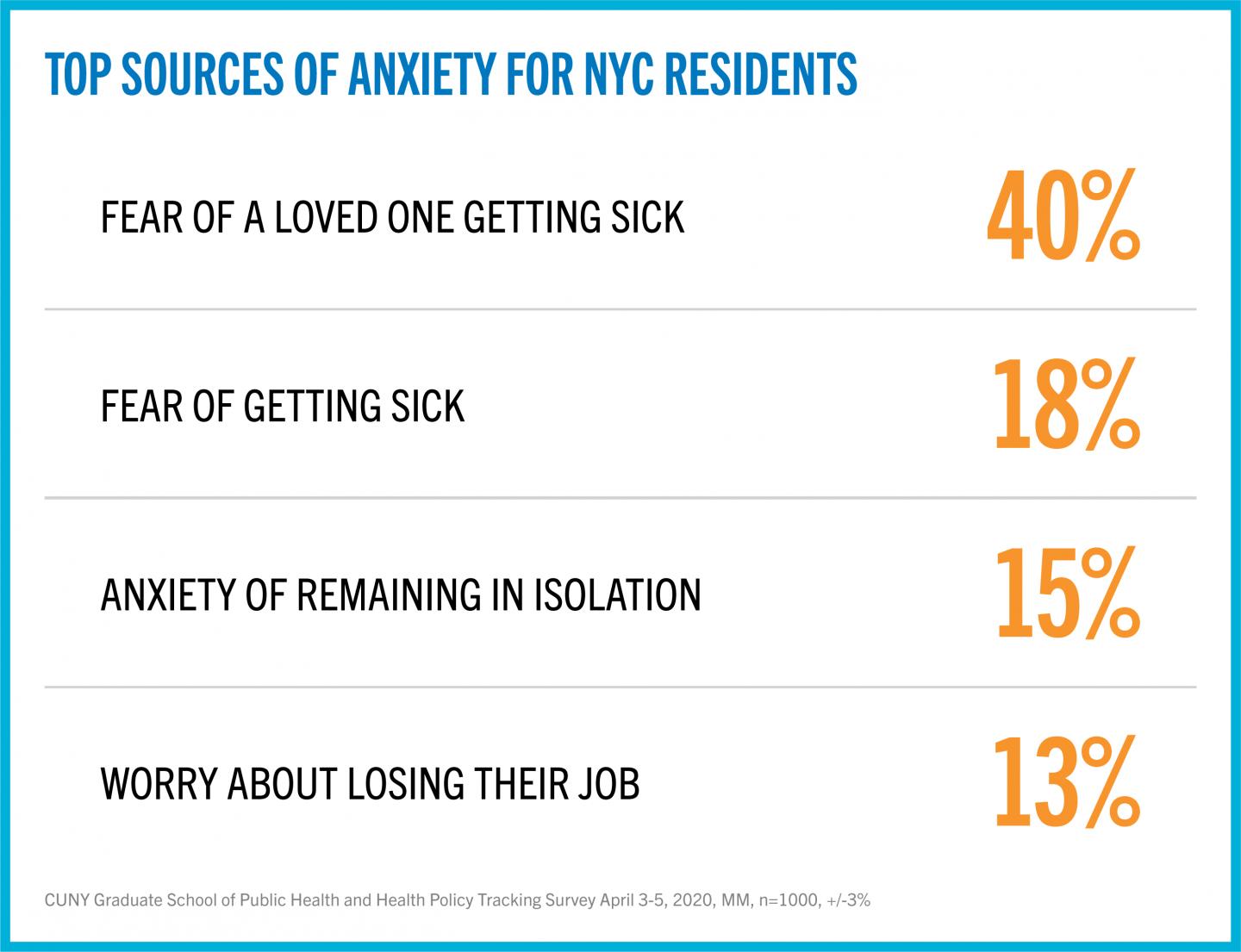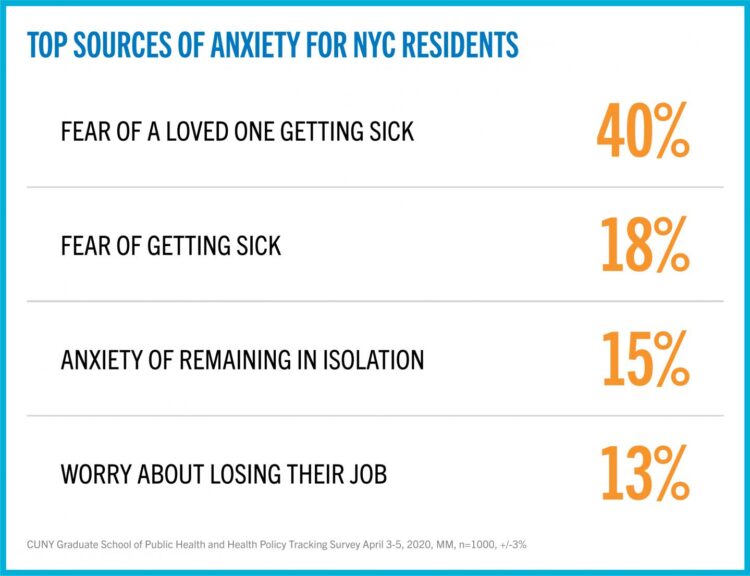New Yorkers seem resigned to a long siege as COVID-19 infection, job loss, food access challenges, depression, anxiety, and hopelessness prevail

Credit: Credit CUNY SPH
The majority of New York City residents expect a long disruption to their daily life. While a quarter (25%) think the epidemic will disrupt their life for less than a month, 27% think its impact will last two months, 20% three months, and a substantial plurality, 28%, anticipate more than four months’ disruption. The findings are part of the fourth weekly city and statewide tracking survey from CUNY Graduate School of Public Health & Health Policy (CUNY SPH), conducted April 3-5.
Forty-three percent (43%) said they know someone who had tested positive for the virus, up substantially from 30% in week three and 15% in week two. An increased number reported having been tested themselves for coronavirus this past week, although the overall numbers remain small: 6% said they had been tested and half (3%) said they had tested positive.
Almost half (48%) of New Yorkers believed they had a high or very high chance of contracting COVID-19, down from 58% last week, but higher than 40% and 43% in the survey’s first two weeks. Of the three regions surveyed (NYC, Long Island, and Upstate NY), Long Island residents continued to report the highest perceived risk of infection. This week 64% of Long Islanders believed they had a high or very high chance of getting sick, up from 57% in week three and 46% in week two. Upstate has consistently reported the lowest perception of risk; this week 40%, up from week three at 36% and week two at 34%. Almost one respondent in eight in New York City (12%) said they have someone sick at home who had symptoms of the virus, essentially the same as last week (13%). On Long Island, nearly one in five (19%), said they have someone at home sick, the same percentage as last week. Upstate only 5% reported someone home sick, down from 7% last week.
The most important factor contributing to coronavirus-related anxiety or depression for 40% of NYC residents is fear of a family member or loved one becoming ill with the virus. Getting sick themselves ranked a distant second at 18%, remaining in isolation was at 15% and fear of job loss was ranked fourth most important at 13%.
“We have read numerous accounts of individual accountability, courage, and even creativity during this difficult time,” said Dr. Ayman El-Mohandes, dean of CUNY SPH. “These findings bear this out. The biggest concern New Yorkers report is not for their own health and safety, their employment or their own isolation, but overwhelmingly for the safety and well-being of their family members and others who are close to them.”
More than three quarters of New Yorkers believe that wearing a mask when outside (a measure intended to prevent asymptomatic people who are infected from transmitting the disease) would be helpful in containing the virus. This idea is more popular than a two-week self-quarantine for all New Yorkers which 61% in week three said it was helpful. The closing of schools and Universities in week one had 72% support but by week two saw support grow to 80%.
Mental Health
This week, when asked about hopefulness, 60% of New Yorkers did not feel hopeful about the future. Lack of hope was highest among Asians 68%, compared to Whites 64%, Latinx/Hispanics 59%, and Blacks 51%, suggesting different emotional reactions to the current challenge amongst different ethnic groups.
“The percentage of New Yorkers who expressed serious mental stress remained consistently high over the past two weeks,” said Dr. Scott Ratzan, distinguished lecturer at CUNY SPH. “As a number of federal and state officials have said that the current week will be a particularly difficult one, it will be important to be vigilant in observing and responding to the community’s level of anxiety, depression and despair.”
Mental health risks have been consistently high across the past two weeks – 40% are socially isolated, 44% feel anxious, and 35% feel depressed at least half of the time.
Women tended to be more depressed than men (38% vs 30%) but there were no differences across gender for hopelessness, social isolation, and anxiety.
As in previous weeks, respondents over 60 were more likely to feel socially isolated when compared to 18-29 year olds (45% vs 31%). Paradoxically, the younger age group was more likely to manifest anxiety (54% vs 34%), depression (40% vs 30%), and hopelessness (68% vs 56%) compared with seniors.
There are also race differences in terms of social isolation. Latinx/Hispanics reported the highest rates at 56% compared with other ethnic minority groups that report between 36-39% and Whites who report 28%. However, there are no race differences in percentages of those endorsing depression and anxiety risk. This pattern is consistent across the last two weeks.
When asked about what contributed to their anxiety or depression, the top stressor was concern about family and loved ones getting sick. For Latinx/Hispanics, Whites, and African Americans, concern about getting sick themselves and about remaining in isolation were the second and third top stressors. Notably, for Asians, the second leading stressor was losing a job rather than getting sick themselves.
Jobs
Household job loss held at 35%, the same as last week (36%), up from 28% in week two. A substantial drop in full time employment, from 47% to 38% over the past four weeks, was reported. Unemployment rose nine points and retirements were up two points. The employment sector hardest hit was leisure and hospitality (37% to 26%). Construction and manufacturing sector employees were the second most impacted (23% to 19%).
Household job loss increased perceived risk of contracting COVID-19 (55% vs 45% of those who did not experience household job loss). Similarly, household job loss increased feelings of hopelessness (66% vs 56%), anxiety (49% vs 41%), and depression (41% vs 31%).
Food Access
Eighty-five percent (85%) reported a reduction in food access with 22% saying the reduction was “a lot”, 36% “somewhat” and 26% “a little.” In week two, 80% had reported reduced food access.
Notably, half of the respondents (50%) said that they believed their diets had become healthier during this time. “More people cooking at home may contribute to a healthier diet,” suggests Nick Freudenberg, distinguished professor of public health and director of the CUNY Urban Food Policy Institute.
Additional Findings
Slightly more than one respondent in five (21%) said they sought healthcare or advice from a health professional about coronavirus, which is essentially the same as the previous week (20%).
About the same percentage of respondents (37% vs 36%) said their medical care for other problems has been cancelled due to the epidemic.
The complete survey results and related commentary can be found at https:/
###
Survey methodology:
The CUNY Graduate School of Public Health and Health Policy (CUNY SPH) survey was conducted by Emerson College Polling from April 3-5, 2020 (week 4). This tracking effort started in March 13-15 (week 1), and continued with questions fielded in March 20-22 (week 2) and March 27-29 (week 3).The sample for the NY Statewide and New York City results were both, n=1,000, with a Credibility Interval (CI) similar to a poll’s margin of error (MOE) of +/- 3 percentage points. The data sets were weighted by gender, age, ethnicity, education and region based on the 2018 1-year American Community Survey model. It is important to remember that subsets based on gender, age, ethnicity and region carry with them higher margins of error, as the sample size is reduced. In the New York City results, data was collected using an Interactive Voice Response (IVR) system of landlines (n=557), SMS-to-online (n=301) and an online panel provided by MTurk and Survey Monkey (n=143). In the Statewide results, data was collected using an Interactive Voice Response (IVR) system of landlines (n=556), SMS-to-online (n=291) and an online panel provided by MTurk and Survey Monkey (n=153).
In the statewide survey regions were broken out into the following:
- Region 1: Long Island 14.7% (USC1-4), Shirley, Seaford, Glen Cove, Garden City
- Region 2: NYC 45.3% (USC 5-16) Queens, Brooklyn, Manhattan, Staten Island, Bronx
- Region 3: Upstate 40% (USC 17-27): Albany, Harrison, Carmel, Rhinebeck, Amsterdam, Schuylerville, Utica, Corning, Irondequoit, Buffalo, Rochester
The CUNY Graduate School of Public Health and Health Policy (CUNY SPH) is committed to teaching, research and service that creates a healthier New York City and helps promote equitable, efficient and evidence-based solutions to pressing health problems facing cities around the world.
Media Contact
Barbara Aaron
[email protected]
Original Source
https:/





